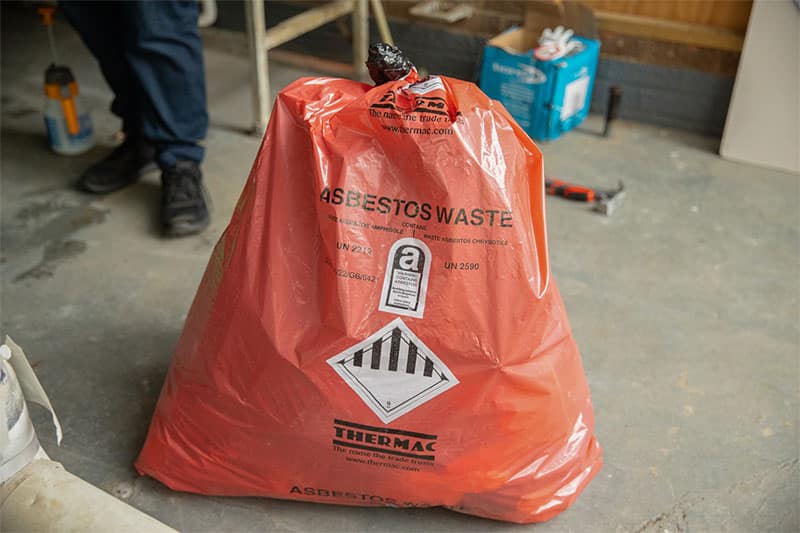What Are the Legal Issues Around Removing Asbestos Yourself?
Despite it being banned in 1999, asbestos exposure is still responsible for more than 5,000 deaths every year in the UK. Any building that dates back before the ban is likely to contain asbestos.
When asbestos is disturbed, it can release microscopic fibres into the air. When inhaled, these fibres attach themselves to the lungs and are impossible to remove, even with medical procedures.
This type of asbestos exposure can lead to serious and life-threatening cancers and other diseases anywhere from a few years to a few decades in the future.
When asbestos-containing materials (ACMs) are found or suspected to be present on your premises, it’s tempting to use a DIY approach to get rid of them. However, this can present both health and legal issues.
Understanding asbestos laws in the UK and your responsibilities is imperative to maintaining a safe building while avoiding law-breaking activities.
What Are the Dangers of Asbestos?
There are six different kinds of asbestos minerals, and all of them are harmful when inhaled. Certain types of asbestos, like chrysotile and amosite asbestos, were regularly used in construction, while others weren’t as common.
While asbestos in good condition doesn’t pose a risk, asbestos that’s naturally breaking down or that’s been damaged needs to be dealt with.
The type of asbestos used determines how brittle and fibrous it is. Compact, dense asbestos and ACMs are less likely to break down over time or become damaged. Fragile types of asbestos pose a great risk, though. And to an untrained person, it’s nearly impossible to know what type of asbestos you’re dealing with.
There are four main health conditions linked to asbestos exposure:
- Asbestosis: This scarring of the lungs can cause shortness of breath that progressively gets worse. In some cases, asbestosis can be fatal.
- Lung Cancer: Asbestos can cause lung cancer in the same way that smoking can.
- Mesothelioma: This is a type of cancer caused by asbestos that affects the lining of the digestive tract and the lungs. Unfortunately, mesothelioma is usually fatal.
- Pleural Thickening: This is when there’s thickening and swelling of the lung lining. Often, this causes chest discomfort and shortness of breath.
No matter what type of asbestos is found on your property or what state it’s in, it should always be handled with the utmost care. There’s no such thing as a safe asbestos exposure event.
DIY Asbestos Removal: What Is the Appeal and What Are the Risks?
Asbestos removal can be an expensive undertaking, and some property managers or homeowners don’t want to pay someone to do what they feel they can do on their own. It’s also unappealing to have contractors come onto your property to take over an entire area.
However, unless you have advanced asbestos training, it’s risky to assess the situation, create a plan of action and handle ACMs on your own. Only an individual or a team with professional expertise knows what to look for and the precautions to take.
Moreover, asbestos removal experts will know the legal requirements to follow so that the building’s duty holder doesn’t get into trouble. And they’ll have the equipment and gear necessary to keep everyone safe until the asbestos is completely gone.
What Are the Regulations and Guidelines That Govern Asbestos Removal?
The Control of Asbestos Regulations 2012 are the UK’s current asbestos rules, requirements and best practices. It covers specifics such as:
- Who has a duty to manage asbestos on a property
- Guidelines for when a licenced asbestos contractor is required
- How to notify the authorities about non-licenced work
Duty of Care in Commercial vs. Residential Properties
The Control of Asbestos Regulations 2012 says that the person responsible for a non-residential building also has a duty to safely manage asbestos on the property. For example, a building’s landlord may be responsible for addressing asbestos issues.
When it comes to residential properties, there isn’t a legal duty of care. That doesn’t mean you shouldn’t be concerned with the presence of ACMs, though.
Licensed vs. Unlicensed Asbestos Removal
Unless you’re working with lower-risk asbestos, you’ll need a licence to remove ACMs. You’ll likely need a licence when working with the following types of asbestos:
- Asbestos dust
- Asbestos insulating board (AIB)
- Loose-fill asbestos
- Pieces of asbestos debris
- Sprayed coatings
Licenced asbestos contractors must notify the Health and Safety Executive (HSE) 14 days before beginning the removal project.
If you’re removing the following types of ACMs and they’re intact, you may not need a licence:
- Asbestos cement products
- Backing board from textured coatings
- Resin-based materials (brake linings, gaskets, etc.)
- Vinyl floor tiles
You must notify the HSE before non-licensed work begins.
DIY Removal vs. Professional Services: Legal Implications
It can be difficult to assess if you’re legally allowed to carry out non-licensed asbestos work. There are a lot of details to consider when deciding if you’re exempt from licensable work. For example:
- What is the concentration of asbestos in the air? It can’t exceed .6f/cm3 within 10 minutes.
- How much asbestos exposure will the workers endure? There’s a legal control limit that it can’t exceed.
- Is the asbestos friable or non-friable? You must know the type of asbestos you’re dealing with.
The unsafe removal of asbestos in the UK can result in serious penalties, including hefty fines and prison.
By hiring licensed asbestos removal professionals, you’ll know that you’re not evading the law and that everyone on the premises will remain safe from asbestos exposure.
At the very least, consult with an asbestos professional before embarking on a DIY asbestos removal job.
Legal Consequences: Penalties and Liabilities
According to the HSE, if you don’t plan for and deal with asbestos removal in the proper way and by following the Control of Asbestos Regulations 2012, you could face serious penalties. These include:
- A fine as high as £20,000
- Up to 12 months of imprisonment
Sometimes, the punishment is even more severe. For example, a construction company was fined £90,000 for an asbestos exposure event during a refurbishment project. The HSE found that the construction company did not determine the location of ACMs prior to the refurbishment, and asbestos debris was found near the building and along the highway.
Also, note that even if you own a vacant building, you still need an asbestos survey in order to make a materials assessment.
Health and Safety Implications: Protecting Yourself and Others
There are a number of health risks to consider when taking a DIY approach to an asbestos removal job. Workers and anyone on the premises are at risk of asbestos exposure, which can cause major health complications in the future.
Without training, you may not even know that ACMs have been damaged or that there are asbestos fibres in the air.
Additionally, non-professionals don’t usually have the necessary personal protective equipment (PPE) or respiratory protective equipment (RPE) that’s needed when working with asbestos. There are also removal guidelines for different types of asbestos. For example, removing asbestos gutters or roofing can be different from working with asbestos sealants.
Proper Disposal: Environmental and Legal Concerns
Aside from removing ACMs from your property, you have to know how to dispose of them. Incorrect disposal can mean that people are still at risk. For example, if you try to bury ACMs, the asbestos can contaminate the soil and possibly get kicked up, which will release fibres.
When disposing of ACMs, specific guidelines must be followed, such as:
- Never break up ACMs to make them easier to dispose of.
- Double-bag asbestos waste and label it.
- Only have someone with the proper licensing transport asbestos.
- Asbestos waste cannot escape while it’s being transported.
Furthermore, there are designated sites where it’s acceptable to dispose of asbestos waste. You have to find the right landfill that can handle the asbestos waste you’re getting rid of.
Conclusion: Prioritising Asbestos Safety and Compliance
The use of asbestos in construction was prevalent before 2000, and there are several sections of UK buildings — some obvious, some not — that may contain asbestos.
Exposure to asbestos can result in fatal diseases anywhere from a few years in the future to four decades later. While DIY asbestos removal may seem like the most convenient option, you can put yourself and everyone else in the building at risk.
Hiring professional asbestos removal experts means covering your bases from the beginning. A thorough assessment will be carried out so a plan of action can be created. From there, asbestos contractors will have the know-how and equipment to remove ACMs and create a safe environment while adhering to asbestos legislation.
That means that as a duty holder, you’ll avoid penalties like imprisonment and fines that are dealt out when asbestos laws are broken.
Always seek professional help when you have asbestos that must be removed.

Written by Callum McDonald
Callum McDonald is an expert in asbestos quality management, ensuring rigorous adherence to regulations and high-quality standards in removal projects. His focus on enhancing quality and client satisfaction makes him a crucial asset in safety and compliance within the field. Callum's expertise in technical support and oversight of licensed works underscores his commitment to excellence in asbestos management, providing invaluable guidance to clients in this specialised area.

